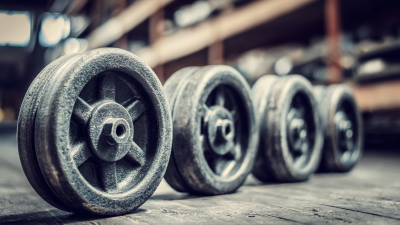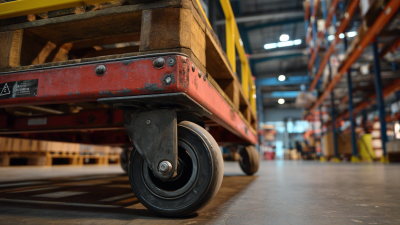
The Top 5 Benefits of Using Cast Iron Casters for Your Heavy-Duty Equipment
In the realm of heavy-duty equipment, the performance and durability of casters play a crucial role in ensuring operational efficiency. According to a report by the Material Handling Industry of America, 70% of material handling systems are affected by caster quality, significantly impacting productivity and safety. Among the various materials available, cast iron casters have emerged as the top choice for many industrial applications due to their exceptional strength and reliability. With a load capacity that can exceed 1,500 pounds, cast iron casters provide unmatched support, making them ideal for heavy-duty equipment. Furthermore, their resistance to wear and ability to withstand harsh environments contribute to reduced maintenance costs and longer service life. This article will explore the top five benefits of using cast iron casters, highlighting not only their advantages in performance but also their significant impact on overall operational efficiency in various industries.

Advantages of Cast Iron Casters in Heavy-Duty Operations
When it comes to heavy-duty operations, the choice of casters is crucial for ensuring efficiency and safety. Cast iron casters have emerged as a popular option due to their durability and strength. One of the primary advantages is their ability to handle significant loads without warping or breaking. This makes them ideal for factories, warehouses, and other demanding environments where heavy machinery is common.
Additionally, cast iron casters provide excellent stability. Their broader footprint distributes weight evenly, reducing the risk of tipping over. This characteristic is particularly beneficial in dynamic work settings where equipment moves frequently. Furthermore, cast iron can withstand various environmental factors, including extreme temperatures and harsh chemicals, making them suitable for diverse applications.
**Tip:** Regular maintenance of your cast iron casters can extend their lifespan. Ensure that they are cleaned of debris and are lubricated periodically to maintain smooth operation.
Moreover, the noise reduction factor is notable as cast iron casters often produce less noise compared to other materials, leading to a quieter work environment. Heavy-duty operations can also benefit from the aesthetic appeal of cast iron, which often complements industrial designs effectively.
**Tip:** Consider the surface type of your work area when selecting casters; using harder wheels on smoother surfaces can improve mobility while minimizing the risk of damage to flooring.
The Top 5 Benefits of Using Cast Iron Casters for Your Heavy-Duty Equipment
| Benefit | Description | Applicable Scenarios | Load Capacity |
|---|---|---|---|
| Durability | Cast iron casters provide exceptional strength and can withstand heavy loads. | Factories, warehouses, and construction sites. | Up to 1,500 lbs. |
| Stability | Designed to offer a stable platform, reducing the risk of tipping. | Heavy-duty machinery and industrial carts. | Varies based on design, approximately 800 - 1,200 lbs. |
| Low Maintenance | Requires minimal upkeep, reducing long-term maintenance costs. | Machinery and equipment exposed to harsh conditions. | Up to 1,000 lbs. |
| Heat Resistance | Can withstand high temperatures suitable for hot environments. | Foundries and cooking equipment. | Up to 1,500 lbs. |
| Versatility | Compatible with various surfaces and applications, enhancing mobility. | Logistics and material handling. | 1,000 - 1,500 lbs. |
Superior Durability and Longevity of Cast Iron Casters
When it comes to heavy-duty equipment, the choice of casters can significantly impact performance and durability. Cast iron casters stand out for their superior durability and longevity, making them an ideal option for demanding environments. Unlike plastic or rubber alternatives, cast iron provides exceptional strength, allowing equipment to withstand heavy loads without bending or warping. This durability ensures that your operations can run smoothly without frequent replacements, ultimately saving time and money.
For those considering cast iron casters, proper maintenance is crucial for maximizing their lifespan. Regularly inspect the casters for signs of wear or damage, and clean them to prevent rust formation. Applying a lubricant can also help minimize friction, allowing for smoother movement and reduced strain on the equipment.
Additionally, when selecting cast iron casters, consider the specific requirements of your applications, such as load capacity and wheel size. Choosing the right type will enhance performance and ensure that your heavy-duty equipment operates at peak efficiency. Investing in high-quality cast iron casters today means fewer headaches tomorrow, allowing you to focus on what truly matters—getting the job done.
The Top 5 Benefits of Using Cast Iron Casters for Your Heavy-Duty Equipment
Enhanced Load-Bearing Capacity for Heavy Equipment
Cast iron casters are an excellent choice for heavy-duty equipment due to their enhanced load-bearing capacity. Unlike plastic or rubber alternatives, cast iron is designed to withstand significant weight, making it ideal for heavy machinery and industrial applications. The sturdiness of cast iron ensures that your equipment remains stable and secure, even when under heavy load. This durability also means longer service life, reducing the frequency of replacements and associated costs.
Tips for selecting the right cast iron casters include assessing the weight of your equipment and the type of surface they will roll on. Ensuring that the load capacity of the caster exceeds your equipment's weight is crucial for safety. Additionally, consider the wheel diameter; larger wheels roll more easily over uneven surfaces, which can further enhance stability and maneuverability.
Another consideration is the wheel design. Choose casters with additional features such as swivel locks or brakes for added control during movement. This feature allows operators to keep equipment securely in place, especially in busy environments, minimizing the risk of accidents. Investing in high-quality cast iron casters ultimately contributes to efficient operations and improved safety standards in your facility.

Smooth Mobility and Maneuverability of Cast Iron Casters
When it comes to heavy-duty equipment, the ability to move smoothly and maneuver with ease is crucial. Cast iron casters provide an excellent solution for enhancing mobility. Their robust construction ensures durability, allowing them to withstand the rigors of heavy loads while maintaining a steady glide across various surfaces. This reliability is particularly advantageous in industrial settings where equipment must be frequently relocated or adjusted.
Moreover, cast iron casters offer superior stability compared to other materials. Their weight helps distribute load evenly, reducing the risk of tipping or misalignment during movement. This characteristic not only enhances operational efficiency but also contributes to the safety of personnel involved in handling heavy machinery. Additionally, their design allows for smooth swiveling, enabling operators to navigate tight spaces effortlessly. The combination of strength and agility makes cast iron casters an ideal choice for anyone looking to optimize the mobility of heavy-duty equipment.
Resistance to Harsh Environments and High Temperatures
When it comes to heavy-duty equipment, the environment in which it operates can greatly impact performance and longevity. This is where cast iron casters stand out, particularly due to their remarkable resistance to harsh conditions. Unlike plastic or rubber casters that may warp or degrade over time, cast iron can endure extreme temperatures and rough surfaces without losing structural integrity. This resilience makes them ideal for industrial settings where thermal fluctuations and abrasive conditions are common.

Moreover, cast iron casters are designed to withstand high temperatures, making them suitable for applications such as foundries and metalworking shops where equipment is regularly exposed to heat. Their ability to maintain functionality under such extreme conditions not only enhances safety but also reduces the frequency of replacements, resulting in cost savings over time. Investing in cast iron casters means investing in durability, ensuring that heavy-duty equipment continues to operate effectively, even in the most demanding environments.
Related Posts
-

How to Choose the Right Iron Castor Wheels for Your Project
-

Understanding Common Issues with Caster Swivel Solutions
-

Innovative Solutions for Cast Iron Caster Applications
-

The Future of Cast Iron Casters in Sustainable Manufacturing
-

Exploring Globe Caster Innovations and Market Trends at the 2025 China Import and Export Fair
-

Maximizing Efficiency with the Best Caster Trolley in Your Operations
